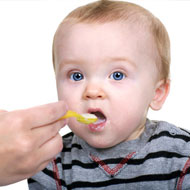- Baby care
- Baby Crying
- Baby Feeding
- Baby Growth
- Baby Language
- Baby Name
- Baby Potty Training
- Baby Safety
- Baby Shower
- Baby Sleep
- Baby Teething
- Bathing a Baby
- Early Pregnancy Signs
- Late Pregnancy
- Miscarriage
- Molar Pregnancy
- Post Pregnancy
- Postpartum Depression
- Pre Pregnancy
- pregnancy care
- Pregnancy Conditions
- Pregnancy Diet
- Pregnancy Due Date
- Pregnancy Exercise
- Pregnancy Heartburn
- Pregnancy Sex
- Pregnancy Sleep
- Pregnancy Stages
- Pregnancy Stretch Marks
- Pregnancy Style and Fashion
- Preschooler
- Second Pregnancy
- Teen Pregnancy
- Toddler Activities
- Toddler Behavior
- Toddler Discipline
- Toddler Food
- Toddler Illness and Injuries
- Toddler Speech
- Twin Pregnancy
Ideas for Feeding Solids to your New Born Baby

The baby’s transition to solid food is an important milestone for both the mother and child. The first step is to ensure that the child is indeed ready for solid foods. Usually at six months, the child is ready to start on solids. Here are some ideas for feeding solids to your new born baby. Since this process requires patience and time, it is better to begin when you and the baby are calm and relaxed. This may be after the baby’s mid-morning feed. When fed, the baby is likely to make a face and spit the food out. This is because he is not used to the taste of the food as well the manner in which it is supposed to be eaten. You need to keep trying to feed him. Holding the baby on your lap sometimes helps or you can also place him in a baby chair. The food that you feed the child needs to be of a smooth consistency. Blending or straining the food until it is free from lumps helps in this regard. The baby is still accustomed to liquids at this stage and hence will not be very receptive to stiff or lumpy foods. Begin with small servings initially.
Solid foods should be introduced one at a time and the same food must be continued for a couple of days before starting on another. This allows the child to become accustomed to the taste and also helps you to understand the child’s tolerance to that particular food. It is also important to remember that babies have more taste buds that adults and as such food should not be prepared according to your own tastes. Salt and sugar rarely need to be added. Solids can be offered to the child during one meal each day. Then it can be increased to a couple of tablespoons at every meal. Then slowly increase the solid food meals to thrice in a day.
Offering the child a combination of food increases variety and stimulates the child’s interest in food. Textures of the food can also be changed as the baby grows. There may be a gagging reflex when the child is first given lumpy foods, but this is only a natural reflex. Finger foods such as bread gingers, soft fruits or pieces of steamed vegetables encourage the child to eat on his own. As the child grows, more flavors and textures can be introduced, thereby encouraging chewing and proper development of the teeth and jaws. Avoid feeding your baby foods like peas, pieces of potato and grapes.
- RSS Feeds -
- All posts
- All comments
- Weaning Breastfeeding Toddler Weaning a breastfeeding toddler can be a difficult task. It is important to r
- Baby Feeding Frequency Nutrition is the most important factor in a growing baby's life. Nutritio
- Baby Feeding Checklist Feeding your new born baby can be an exciting and new experience but after a
- Baby Feeding At 5 Months Nourishment is extremely important throughout the life of an individual. Nour